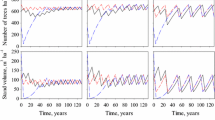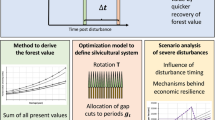Abstract
The Faustmann forest rotation model is a celebrated contribution in economics. The model provides a forest value expression and allows a solution to the optimal rotation problem valid for perpetual rotations of even-aged forest stands. However, continuous forest cover forest management systems imply uneven-aged dynamics, and while a number of numerical studies have analysed specific continuous cover forest ecosystems in search of optimal management regimes, no one has tried to capture key dynamics of continuous cover forestry in simple mathematical models. In this paper we develop a simple, but rigorous mathematical model of the continuous cover forest, which strictly focuses on the area use dynamics that such an uneven-aged forest must have in equilibrium. This implies explicitly accounting for area reallocation and for weighting the productivity of each age class by the area occupied. We present results for unrestricted as well as area-restricted versions of the models. We find that land values are unambiguously higher in the continuous cover forest models compared with the even-aged models. Under area restrictions, the optimal rotation age in a continuous cover forest model is unambiguously lower than the corresponding area restricted Faustmann solution, while the result for the area unrestricted model is ambiguous.



Similar content being viewed by others
Notes
We use the term “continuous cover”. “Uneven-aged” is also used frequently in the literature—mostly as a direct synonymous.
This only holds under the conditions of no regeneration costs and no price-dependency on tree size. Two simplifying assumptions we maintain in this paper.
Morsing (2001) and as early as Muus (1921) mention the importance of distribution of area utilization between trees and the fact that in uneven-aged management more space can be occupied by larger trees that may have a higher value growth per area and time unit, relative to the Faustmann normal forest case. However, little empirical evidence exist (O’Hara and Nagel 2006) which can attribute the difference solely due to different structures.
Notice that the classic Faustmann model and also our interpretation here are neglecting thinnings—of evenaged trees. In reality these may play a substantial role for the area utilization, and the setup can be expanded to that cover that situation, but at a loss of mathematical tractability in particular in the CCF case.
We do not discuss the issues of competition, crown development and stem growth in more detail here. By ‘adequate’ we mean to imply a development known to result in healthy growth and good stem quality.
As did Faustmann and many others. Alternatives could be size, diameter or value, but as we like Faustmann assume an identical age-size-value relationship for all individual trees—and across the forest types, age is as appropriate as size.
By this assumption we avoid the need for multiple state variable models, and this eases the comparison of the models. We discuss the consequence of this assumption later.
To ease interpretation, we use a slightly different notation from that in Faustmann’s original paper.
In a normal forest an equal area is allocated to all T age classes and therefore T becomes both the number of age classes and the rotation period.
Remember that definite integrals are defined as limits on upper and lower boundaries on integration variables. Thus, in the third term we do not integrate over i \(=\) t but only a time approximately close to i and in (21) i \(=\) t in the third term is captured by the second term. Likewise, we only get approximately close to T at the upper limit of the integral. In this way we avoid double counting because we have a discontinuity in a(t) at T.
A requirement for the Taylor series approximation is continuity of the objective function with respect to a, m and t. This is also a requirement in most other economic models used for optimization (Varian 1992), including the ones earlier in this paper, and it will hold for most functional forms that can be imagined in the current setting.
This function is chosen as the driving factor for both m and a is the biological growth—and limits imposed by competition for resources. For realistic assumptions of price development (e.g. that price increase by dimension, but only until dimensions are too large to handle) this general functional form is not contradicted. Thus, by working with a Gompertz function it is generalized to a relatively flexible form.
References
Adams DM, Ek AR (1974) Optimizing the management of uneven-aged forest stands. Can J For Res 4:274–287
Amacher G, Ollikainen M, Koskela E (2009) Economics of forest resources. The MIT Press, Cambridge
Beverton RJH, Holt SJ (1957) On the dynamics of exploited fish populations. Fishery investigations series II, vol XIX. Ministry of Agriculture, Fisheries and Food, London
Buongiorno J (2001) Quantifying the implications of transformation from even to uneven-aged forest stands. For Ecol Manag 151:121–132
Brukas V, Thorsen BJ, Helles F, Tarp P (2001) Discount rate and harvest policy: implications for Baltic Forestry. For Policy Econ 2:143–156
Chang SJ (1981) Determination of the optimal growing stock and cutting cycle for an uneven-aged stand. For Sci 27:739–744
Conrad JM, Clark CW (1991) Natural resource economics: notes and problems. Cambridge University Press, Cambridge
Faustmann M (1849) Calculation of the value which forest lad and immature stands possess for forestry. Reprinted in J For Econ (1995) 1:7–44, From the original: Berechnung des Wertes welchen Waldboden sowie noch nicht haubare Holzbestände für die Waldwirtschaft besitzen, Allgemeine Forst- und Jagdzeitung, vol 15
Haight RG (1985) A comparison of dynamic and static economic models of uneven-aged stand management. For Sci 31:957–974
Haight RG (1990) Feedback thinning policies for uneven-aged stand management with stochastic prices. For Sci 36:1015–1031
Hanewinkel M (2001) Economic aspects of the transformation from even-aged pure stands of Norway spruce to uneven-aged mixed stands of Norway spruce and beech. For Ecol Manag 151:181–193
Hartman R (1976) The harvesting decision when a standing forest has value. Econ Inq 14:52–58
Heaps T (1984) The forestry maximum principle. J Econ Dyn Control 7:131–151
Heshmatol Vaezin SM, Peyron J-L, Lecocq F (2009) A simple generalization of the Faustmann formula to tree level. Can J For Res 39:699–711
Jacobsen JB, Helles F (2006) Adaptive and non-adaptive harvesting in uneven-aged beech forest with stochastic prices. For Policy Econ 8(3):223–238
Jacobsen JB, Vedel SE, Thorsen BJ (2013) Assessing costs of multifunctional NATURA 2000 management restrictions in continuous cover beech forest management. Forestry 85(5):575–582
Knoke T, Plusczyk N (2001) On economic consequences of transformation of spruce (Picea abies L. Karst) dominated stands from regular into irregular structure. For Ecol Manag 151:163–179
Kuuluvainen T, Tahvonen O, Aakala T (2012) Even-aged and uneven-aged forest management in boreal Fennoscandia: a review. Ambio 41:720–737
Lundgren T (2005) Assessing the investment performance of Swedish Timberland: a capital asset pricing model approach. Land Econ 81:353–362
Meilby H, Nord-Larsen T (2012) Spatially explicit determination of individual tree target diameters in beech. For Ecol Manag 270:291–301
Ministry of the Environment (2002) The Danish national forest programme in an international perspective. Danish Forest and Nature Agency, Copenhagen
Morsing M (2001) Simulating selection system management of European beech (Fagus sylvatica L.). PhD Dissertation, The Royal Veterinary and Agricultural University and Danish Forest and Landscape Research Institute, Frederiksberg, Denmark
Möhring B (2001) The German struggle between the ’Bodenreinertragslehre’ (land rent theory) and ’Waldreinertragslehre’ (theory of the highest revenue) belongs to the past—but what is left? For Policy Econ 2:195–201
Muus F (1921) Forsyndelser mod skovnaturen ved vor almindelige skovdrift [Sins against the forest’s nature in our normal forestry]. Dan Skovbr Tidsskr 6:1–21
National Assembly for Wales (1999) Woodland for Wales. Forestry Commision, Aberystwyth
Nautiyal JC (1983) Towards a method of uneven-aged forest management based on the theory of financial maturity. For Sci 29:47–58
Navarro GA (2003) Re-examining the theories supportimg the so-called Faustmann Formula. In: Helles F, Strange N, Wichmann L (eds) Recent accomplishments in applied forest economics research forestry sciences. Kluwer, Dordrecht, pp 19–38
Neher PA (1990) Natural resource economics. Conservation and exploitation. Cambridge University Press, Melbourne
Newman DH (2002) Forestry’s golden rule and the development of the optimal forest rotation literature. J For Econ 8:5–27
Niedersächsisches Forstplannungsamt (1995) Waldprogram Niedersachen [Forest program for Lower Saxony]. Niedersächsische Ministerium für Ernährung, Landwirtschaft und Forsten
Nord-Larsen T, Meilby H, Lomholt A, Skovsgaard JP (2009) Vidar - et program til opstilling af lokale produktionsoversigter [Vidar - a program for generation of local production tables]. Skoven 41:290–292
O’Hara KL, Nagel LM (2006) A functional comparison of productivity in even-aged and multiaged stands: a synthesis for Pinus ponderosa. For Sci 52(3):290–303
Ohlin B (1921) Till frågan om skogarnas omloppstid. Ekonomisk Tidsskrift 22:89–113. Reprinted as Ohlin B (1995) Concerning the question of the rotation period in forestry. J For Econ 1(1):89–114
Pressler MR (1860) Aus die Holzzuwachlehre. Allgemeine Forst- und Jagdzeitung 36:173–191. Reprinted as Pressler MR (1995) For the comprehension of net revenue silviculture and the management objectives derived thereof. J For Econ 1(1):45–88
Price C (2003) The economics of transformation from even-aged to uneven-aged forestry. In: Helles F, Strange N, Wichmann L (eds) Recent accomplishments in applied forest economics research forestry sciences. Kluwer, Dordrecht, pp 3–17
Price M, Price C (2006) Creaming the best, or creatively transforming? Might felling the biggest trees first be a win-win strategy? For Ecol Manag 224:297–303
Pukkala T, Kolström T (1988) Simulation of the development of Norway spruce stands using a transition matrix. For Ecol Manag 25:255–267
Reed WJ (1986) Optimal harvesting models in forest management—a survey. Nat Resour Model 1:55–79
Rämö J, Tahvonen O (2015) Optimizing the harvest timing in uneven-aged forestry. Paper presented at the 21 annual conference of the European association of environmental and resource economics, Helsinki, 24–27 June 2015. http://www.webmeets.com/eaere/2015/prog/viewpaper.asp?pid=791
Schou E, Jacobsen JB, Kristensen KL (2012) An economic evaluation of strategies for transforming even-aged into near-natural forestry in a conifer-dominated forest in Denmark. For Policy Econ 20:89–98
Salo S, Tahvonen O (2002) On the optimality of a normal forest with multiple land classes. For Sci 48:530–542
Samuelson PA (1976) Economics of forestry in an evolving society. Reprintet in: J For Econ (1995) 1:115–149
Spiecker H, Hansen J, Klimo E, Skovsgaard JP, Sterba H, von Teuffel K (2004) Norway spruce conversion: options and consequencs. European Forest Institute, Research report 18. Brill Academic Publishers, Leiden
Tahvonen O (2009) Optimal choice between even- and uneven-aged forestry. Nat Resour Model 22:289–321
Tarp P, Helles F, Holten-Andersen P, Larsen JB, Strange N (2000) Modelling near-natural silvicultural regimes fo beech—an economic sensitivity analysis. For Ecol Manag 130:187–198
Thorsen BJ (2010) Risk, returns and possible speculative bubbles in the price of Danish forest land? In: Helles F, Nielsen PS (eds) Proceedings of the Biennial meeting of the Scandinavian Society of Forest Economics, 19–22 May 2010, Gilleleje, Denmark, pp 100–111
Varian HR (1992) Microeconomic analysis. Norton, New York
Washburn CL, Binkley CS (1990) On the use of period-average stumpage prices to estimate forest asset pricing models. Land Econ 66:379–393
Washburn CL, Binkley CS (1993) Do forest assets hedge inflation. Land Econ 69:215–224
Wollborn P (2000) Ist weniger mehr? Gedanjen zu Ergebnissen und betriebswirtschaftlichen Auswirkungen einer naturnahen Waldwirtschaft in der Niedersächsischen Landesforstverwaltung [Is less more? Reflections on the results and economical effects of ecological orientated forestry in the lower saxony forest administration]. Forst und Holz 55:202–207
Acknowledgements
We would like to than Colin Price and Finn Helles for constructive commenting on several previous versions of this paper, helping clearing the thoughts and for continuously urging us to finalize it. Furthermore, we would like to thank participants on the Fifth World Congress of Environmental and Resource Economists 2014 and the Biennial meeting of the Scandinavian Society of Forest Economics 2014 for comments on an earlier version of the paper. Jette Bredahl Jacobsen and Bo Jellesmark Thorsen acknowledge support from the Danish National Research Foundation to the Center for Macroecology and Climate.
Author information
Authors and Affiliations
Corresponding author
Rights and permissions
About this article
Cite this article
Jacobsen, J.B., Jensen, F. & Thorsen, B.J. Forest Value and Optimal Rotations in Continuous Cover Forestry. Environ Resource Econ 69, 713–732 (2018). https://doi.org/10.1007/s10640-016-0098-z
Accepted:
Published:
Issue Date:
DOI: https://doi.org/10.1007/s10640-016-0098-z




